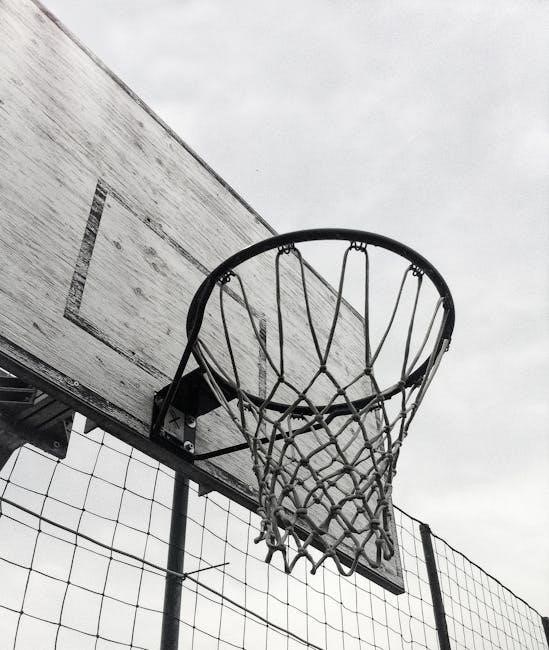A basketball court diagram with labels is a visual tool essential for understanding court dimensions‚ markings‚ and key areas. It aids in strategy development‚ player training‚ and game analysis‚ providing a clear layout for coaches and players to visualize plays and drills effectively.
Overview of Basketball Court Diagrams
Basketball court diagrams are detailed visual representations of the court‚ showcasing its dimensions‚ markings‚ and key areas. They are available in various formats‚ including full-court‚ half-court‚ and combination layouts. These diagrams are essential for coaches‚ players‚ and analysts to strategize‚ design plays‚ and understand the court’s structure. Labels on the diagrams highlight important features like the free-throw line‚ three-point line‚ and midcourt line‚ ensuring clarity and precision. Whether for scouting‚ training‚ or game planning‚ basketball court diagrams serve as versatile tools to enhance understanding and execution of the game. Their accuracy and detail make them indispensable for effective basketball strategy development and implementation.
Importance of Labeled Diagrams for Players and Coaches
Labeled basketball court diagrams are crucial for players and coaches as they provide a clear understanding of the court’s structure and key areas. These diagrams help players identify strategic positions‚ such as the free-throw line and three-point line‚ while coaches can use them to design effective plays and drills. The labels enhance communication‚ ensuring everyone understands the terminology and spatial relationships. Additionally‚ labeled diagrams aid in visualizing game strategies‚ improving practice efficiency‚ and analyzing opponent tactics. They are an essential tool for teaching the game‚ fostering better teamwork‚ and elevating performance at all skill levels‚ from youth leagues to professional play.
Common Uses of Basketball Court Diagrams
Basketball court diagrams with labels are widely used for planning strategies‚ analyzing games‚ and educating players. Coaches often use them to design plays‚ visualize drills‚ and communicate tactical positions effectively. Players benefit by understanding spatial relationships and key areas like the free-throw line and three-point line. These diagrams also aid in scouting opponents‚ breaking down game footage‚ and preparing for matches. Additionally‚ they are invaluable for teaching the fundamentals of the game‚ helping younger players learn court awareness and strategic movement. Overall‚ labeled diagrams are essential tools for improving performance‚ enhancing teamwork‚ and achieving success in basketball at all levels of play.

Types of Basketball Court Diagrams
Basketball court diagrams include full-court‚ half-court‚ and combination layouts. Full-court diagrams show the entire playing area‚ while half-court focus on one end. Combination diagrams blend both views for detailed strategy planning and drills‚ offering flexibility for coaches and players to analyze and visualize plays effectively.
Full Court Diagrams
Full court diagrams provide a comprehensive view of the entire basketball court‚ detailing all key areas and markings. These diagrams are essential for coaches and players to visualize strategies‚ such as full-court presses‚ press breakers‚ and drills. They include labels like the three-point line‚ free-throw line‚ midcourt line‚ and paint area‚ offering clarity for game planning. Available as PDFs‚ full court diagrams are printable and often feature note-taking sections for tactical notes. They are ideal for designing plays‚ analyzing opponent strategies‚ and teaching players positioning and movement. This detailed layout ensures everyone understands their roles and the court’s dimensions‚ enhancing teamwork and performance.
Half Court Diagrams
Half court diagrams focus on one half of the basketball court‚ highlighting key areas such as the free-throw line‚ three-point line‚ and paint area. These diagrams are ideal for analyzing offensive and defensive strategies‚ as they provide a detailed view of the scoring zone. Often used for drills and training‚ half court diagrams are available in PDF formats‚ making them easy to print and share. They are particularly useful for coaches to design plays‚ scout opponents‚ and teach players about spacing and movement within a specific area. The compact layout allows for focused analysis‚ enhancing understanding of half-court dynamics and player positioning.
Combination Full and Half Court Diagrams
Combination full and half court diagrams offer a versatile tool for coaches and players‚ providing a comprehensive view of both the entire court and its half-court sections. These diagrams are ideal for designing plays that transition between full-court presses and half-court offenses or defenses. They often include space for notes‚ allowing users to strategize and visualize game scenarios effectively. Available in PDF formats‚ these diagrams are perfect for scouting‚ practice planning‚ and game analysis. By combining both views‚ they enable a deeper understanding of court dynamics‚ making them indispensable for developing cohesive strategies and adapting to various game situations seamlessly.

Standard Basketball Court Dimensions
Standard basketball court dimensions vary by level‚ with professional courts measuring 94ft by 50ft. Key markings include the three-point line‚ free-throw line‚ and midcourt line‚ essential for strategy and rule understanding.
NBA Court Dimensions
NBA courts measure 94 feet in length and 50 feet in width‚ providing ample space for professional play. Key markings include a 15-foot free-throw line‚ a 23-foot 9-inch three-point line‚ and a midcourt line dividing the court. The paint area is 16 feet wide‚ with the basket positioned at the center. The coaching box is optional‚ located near the scorer’s table. These precise measurements ensure consistency and fairness in gameplay‚ allowing players and coaches to strategize effectively using basketball court diagrams with labels‚ which visually outline these dimensions for better understanding and tactical planning.
College and High School Court Dimensions
College and high school basketball courts share the same dimensions‚ measuring 94 feet in length and 50 feet in width. The three-point line is 20 feet 9 inches from the basket‚ while the high school three-point line is slightly shorter at 19 feet 9 inches. The free-throw line is 15 feet from the basket in both cases. The midcourt line divides the court into two halves‚ and the paint area is 12 feet wide at the college level. These dimensions are slightly smaller than NBA courts but provide a balanced playing field for younger athletes. Basketball court diagrams with labels help visualize these measurements for coaching and training purposes.
International Basketball Court Dimensions
International basketball courts‚ governed by FIBA‚ measure 28 meters in length and 15 meters in width. The three-point line is 6.75 meters from the basket‚ while the free-throw line is 4.5 meters away. The paint area‚ or the free-throw lane‚ is 4.5 meters wide. These dimensions slightly differ from NBA and college courts‚ emphasizing a balanced layout for global competitions. Basketball court diagrams with labels provide clear visual references for players‚ coaches‚ and officials to understand the court layout and strategic positions effectively. This standardized size ensures consistency in international games‚ making it easier for teams to adapt and compete globally.

Key Markings on a Basketball Court
The free-throw line‚ three-point line‚ and midcourt line are essential markings. The free-throw line is 4.5 meters from the basket‚ while the three-point line varies by league. Midcourt divides the court into two halves‚ aiding in strategic positioning and gameplay execution.
Free-Throw Line and Lane
The free-throw line is a crucial marking on the basketball court‚ positioned 4.5 meters (15 feet) from the backboard. It is part of the free-throw lane‚ which is a rectangular area extending 5.8 meters (19 feet) wide. The lane includes the semicircle at the top‚ with a radius of 1.8 meters (6 feet)‚ where players shoot free throws. In labeled diagrams‚ these measurements are clearly indicated‚ helping players and officials understand the rules and spacing. The free-throw line and lane are essential for accurate foul shots and rebounding strategies‚ making them a focal point in basketball court layouts.
Three-Point Line
The three-point line is a critical marking on basketball court diagrams‚ indicating the area beyond which field goals score three points. Its distance varies by league: 7.24 meters (23’9″) in the NBA‚ 6.75 meters (22’1.75″) in college and high school‚ and 6.6 meters (21’8″) in FIBA competitions. This line is clearly labeled in diagrams‚ often highlighted for visibility‚ and plays a key role in modern basketball strategy. The three-point line’s position influences offensive and defensive tactics‚ making it a vital reference point for players‚ coaches‚ and analysts. Accurate representation in diagrams ensures precise understanding of shooting ranges and court spacing.
Midcourt Line
The midcourt line‚ also known as the half-court line‚ is a crucial marking on basketball court diagrams. It divides the court into two equal halves and serves as a key reference point for gameplay strategies. Positioned at the center of the court‚ this line is essential for jump balls‚ determining possession‚ and planning offensive and defensive plays. In labeled diagrams‚ the midcourt line is clearly highlighted to provide players and coaches with a visual guide for spatial awareness and tactical execution. Its accurate representation ensures clarity in understanding court dynamics and executing game plans effectively.

Benefits of Using Labeled Basketball Court Diagrams
Labeled basketball court diagrams enhance strategy development‚ improve player understanding‚ and facilitate efficient scouting and analysis. They provide clarity on court markings and key areas‚ aiding in effective planning and execution.
Enhanced Strategy Development
Labeled basketball court diagrams are invaluable for enhancing strategy development. They provide a clear visual representation of the court‚ allowing coaches and players to design and execute plays effectively. By highlighting key areas such as the three-point line‚ free-throw lane‚ and midcourt line‚ these diagrams enable precise tactical planning. Coaches can use them to map out offensive and defensive plays‚ while players can better understand their roles and positioning. The ability to visualize strategies on a labeled diagram ensures that teams can prepare and adapt more efficiently‚ leading to improved performance on the court.
Improved Player Understanding
Labeled basketball court diagrams significantly enhance player understanding by providing a clear visual representation of the court. Players can easily identify key areas such as the free-throw line‚ three-point line‚ and midcourt line‚ which helps them grasp spatial awareness and positioning. These diagrams allow players to better comprehend their roles and responsibilities within plays‚ fostering a deeper understanding of the game. Coaches can use labeled diagrams to teach players about offensive and defensive assignments‚ ensuring everyone is aligned with the team’s strategy. This clarity is especially beneficial for younger or less experienced players‚ helping them develop a stronger foundational knowledge of basketball fundamentals.
Efficient Scouting and Analysis

Labeled basketball court diagrams are indispensable tools for efficient scouting and analysis. Coaches and analysts can use these diagrams to map opponents’ strategies‚ track player movements‚ and identify trends. By visualizing game plays on a labeled court‚ teams can pinpoint strengths and weaknesses‚ enabling more informed decision-making; The diagrams also allow for detailed breakdowns of offensive and defensive patterns‚ facilitating the development of counter-strategies. This visual approach streamlines the scouting process‚ making it easier to prepare for upcoming games and improve overall performance. The clarity provided by labeled diagrams ensures that insights are actionable and tailored to specific team needs.

How to Create Custom Basketball Court Diagrams
Use graphic design software or online tools to create custom basketball court diagrams. Add labels‚ markings‚ and dimensions to suit your needs for drills‚ plays‚ and analysis.
Using Graphic Design Software
Graphic design software like Adobe Illustrator or ConceptDraw DIAGRAM offers powerful tools to create custom basketball court diagrams. These programs provide templates and libraries with basketball-related elements‚ allowing users to design detailed court layouts. With features like drag-and-drop functionality‚ users can easily add labels‚ markings‚ and dimensions to the court. Customizable templates enable the creation of full-court or half-court diagrams‚ tailored for specific strategies or drills. The ability to adjust colors‚ fonts‚ and placements ensures a professional finish. These tools are ideal for coaches and players seeking precise visual aids to enhance game planning and practice sessions.
Online Tools for Diagram Creation
Online tools like HoopTactics and ConceptDraw DIAGRAM offer intuitive platforms for creating basketball court diagrams. These tools provide pre-designed templates and drag-and-drop features‚ making it easy to customize court layouts. Users can add labels‚ markings‚ and dimensions to create detailed diagrams for strategy‚ scouting‚ or play design. Many tools support exporting diagrams as PDFs‚ ensuring high-quality prints. These platforms are accessible without advanced design skills‚ making them ideal for coaches‚ players‚ and analysts. With features like real-time collaboration and cloud storage‚ online tools streamline the process of creating and sharing basketball court diagrams efficiently.
Best Practices for Labeling
When creating basketball court diagrams‚ clear and consistent labeling is crucial for effective communication. Use bold‚ easy-to-read fonts and ensure labels are proportionate to the diagram size. Highlight key areas like the free-throw line‚ three-point line‚ and midcourt line for quick reference. Maintain color consistency for different zones‚ such as the paint area or sidelines‚ to avoid confusion. Include a legend or key if using complex markings. Avoid clutter by spacing labels appropriately and ensuring readability. Use standard terminology to ensure universal understanding. Finally‚ double-check all labels for accuracy before printing or sharing the diagram to ensure it is a reliable resource for coaches and players.

Downloading Basketball Court Diagrams as PDF
Downloading basketball court diagrams as PDFs is straightforward‚ with many websites offering free templates. Ensure the diagrams are high-resolution and include labeled markings for clarity. Popular sites provide customizable options‚ allowing users to print full or half-court layouts. Always verify the source for accuracy and check dimensions match your needs‚ whether for NBA‚ college‚ or international courts. This ensures the diagrams are reliable and suitable for coaching‚ training‚ or strategic planning purposes.
Steps to Download and Print
To download and print basketball court diagrams‚ visit reputable websites offering free PDF templates. Click on the desired diagram link‚ such as full-court or half-court layouts‚ and save the PDF to your device. Ensure the file is high-resolution for clarity. Choose print settings that match your needs‚ selecting portrait or landscape orientation. Many diagrams include note-taking spaces‚ making them ideal for strategy planning. Verify the court dimensions align with your requirements‚ whether for NBA‚ college‚ or international standards. Print on standard paper or cardstock for durability. These diagrams are perfect for coaches‚ players‚ and analysts to visualize plays‚ drills‚ and game strategies effectively.
Popular Websites for Free Downloads
Several websites offer free basketball court diagram PDFs for download. HoopTactics.net and CoachingU.com provide a variety of labeled diagrams‚ including full-court and half-court layouts. HoopsU.com offers blank and labeled courts for strategy planning. ConceptDraw.com features templates for creating custom diagrams. These sites cater to coaches‚ players‚ and analysts‚ offering tools for play design‚ scouting‚ and drills. Many diagrams are available in multiple formats‚ such as NBA‚ college‚ and international court dimensions. Ensure the source is reputable to guarantee accurate and high-quality downloads. These resources are invaluable for enhancing basketball strategy development and practice planning.
Ensuring High-Quality Prints
To ensure high-quality prints of basketball court diagrams‚ use high-resolution PDF files. Choose a reputable source like HoopTactics.net or CoachingU.com for clear and detailed diagrams. Print on standard paper sizes‚ such as 8.5×11 inches‚ using a laser printer for crisp text and lines. Adjust the printer settings to “Actual Size” to maintain scale. For large diagrams‚ consider poster-sized prints. Ensure the ink levels are sufficient to avoid faded markings. Use bright white paper for optimal visibility. Properly aligned margins and accurate scaling are crucial for professional-looking prints. These tips guarantee your diagrams are legible and effective for strategy sessions or practice drills.

Applications of Basketball Court Diagrams
Basketball court diagrams are used for coaching‚ play design‚ and player training. They aid in visualizing strategies‚ analyzing games‚ and creating drills‚ enhancing both team and individual performance effectively.
Coaching and Play Design
Basketball court diagrams with labels are indispensable tools for coaches‚ enabling them to design and communicate plays effectively. By visualizing the court layout‚ coaches can strategize player positions‚ movements‚ and assignments. These diagrams allow for precise planning of offensive and defensive schemes‚ ensuring clarity for players. Coaches can mark key areas like the free-throw line‚ three-point line‚ and midcourt line‚ making it easier to illustrate tactics. The diagrams also provide space for notes‚ helping coaches analyze opponent weaknesses and adapt strategies. This visual aid enhances teamwork‚ ensuring everyone understands their roles and the overall game plan‚ leading to improved performance on the court.
Player Training and Drills
Basketball court diagrams with labels are essential for player training‚ helping athletes understand positions‚ movements‚ and assignments. These diagrams allow coaches to design drills targeting specific skills‚ such as free-throw shooting or three-point accuracy. Players can visualize their roles in offensive and defensive plays‚ improving execution. The labeled markings‚ like the midcourt line and paint area‚ guide players during practice‚ ensuring they master key areas. Coaches can also use these diagrams to create custom drills‚ fostering teamwork and individual improvement. By providing a clear visual reference‚ basketball court diagrams enhance player development and preparation‚ making training sessions more structured and effective.
Game Analysis and Strategy
Basketball court diagrams with labels are invaluable for game analysis and strategy development. Coaches and players can use these diagrams to map out plays‚ identify key areas‚ and review game footage. The labeled markings‚ such as the free-throw line and three-point line‚ provide clarity in understanding player positioning and movement. By analyzing these diagrams‚ teams can identify strengths‚ weaknesses‚ and opponent tendencies‚ enabling more effective game planning. The diagrams also help in breaking down performance metrics‚ such as shot distribution and defensive alignments‚ allowing for data-driven strategic adjustments. This tool enhances decision-making and execution‚ making it a cornerstone of modern basketball strategy and preparation.

Advanced Features of Basketball Court Diagrams
- Interactive diagrams allow real-time adjustments and simulations.
- Customizable templates enable personalized layouts and markings.
- Integration with sports analytics enhances strategic planning and performance tracking.
Interactive and Dynamic Diagrams
Interactive basketball court diagrams offer a dynamic way to visualize strategies and drills. With digital tools‚ users can drag-and-drop players‚ adjust formations‚ and simulate game scenarios in real-time. These diagrams are particularly useful for coaches to demonstrate plays and for players to understand their roles better. The ability to make on-the-fly adjustments enhances learning and preparation. Additionally‚ interactive diagrams can be shared easily‚ fostering collaboration among teams. This technology bridges the gap between theory and practice‚ making it an invaluable resource for modern basketball training and analysis. They are accessible online and often come with customizable features to suit various coaching needs.
Customizable Templates
Customizable basketball court templates allow users to tailor diagrams to specific needs‚ offering flexibility for coaches and players. These templates provide various court sizes‚ including NBA‚ college‚ and international dimensions‚ enabling adjustments for different strategies. Tools like ConceptDraw DIAGRAM and HoopTactics offer editable layouts‚ saving time and enhancing productivity. Users can modify labels‚ add markings‚ and design plays efficiently. These templates cater to diverse skill levels and training focuses‚ making them invaluable for practice planning and game analysis. Their adaptability ensures they meet the unique requirements of each team‚ fostering effective communication and strategic development in basketball training and gameplay.
Integration with Sports Analytics
Integrating basketball court diagrams with sports analytics enhances strategic planning and performance analysis. Advanced tools allow coaches to overlay data onto court diagrams‚ visualizing player movements‚ shot zones‚ and defensive patterns. This integration enables detailed analysis of game strategies‚ helping teams optimize plays and identify trends. By combining visual representations with statistical insights‚ coaches can make data-driven decisions‚ improving training and gameplay efficiency. Such integration is a powerful resource for modern basketball‚ bridging the gap between visual strategy and numerical analysis to gain a competitive edge.
Basketball court diagrams with labels are indispensable tools for strategy‚ training‚ and analysis. Their versatility and availability in PDF formats make them accessible for coaches‚ players‚ and enthusiasts worldwide.
Final Thoughts on the Importance of Basketball Court Diagrams
Basketball court diagrams with labels are essential for enhancing strategy‚ improving player understanding‚ and facilitating efficient scouting. They provide a clear visual representation of the court‚ making it easier for coaches and players to communicate and execute plays effectively. These diagrams are versatile tools that cater to various needs‚ from designing drills to analyzing game strategies. Their availability in PDF formats ensures accessibility‚ allowing users to download and print them conveniently. Whether for professional or amateur use‚ labeled basketball court diagrams remain a cornerstone in the sport‚ offering a practical and efficient way to visualize and plan basketball tactics.
Future Trends in Basketball Court Diagram Technology
The future of basketball court diagram technology lies in enhanced interactivity and customization. Advances in software will enable dynamic diagrams that adapt to specific strategies or player positions. Integration with sports analytics will allow real-time data visualization‚ providing deeper insights for coaches and players. Customizable templates will become more prevalent‚ enabling users to tailor diagrams to their needs. Additionally‚ augmented reality (AR) and 3D modeling could revolutionize how diagrams are used‚ offering immersive training and planning experiences. These innovations will make basketball court diagrams indispensable tools for modern coaching and player development‚ ensuring they remain central to the sport’s strategic evolution.

0 comments on “basketball court diagram with labels pdf”Add yours →